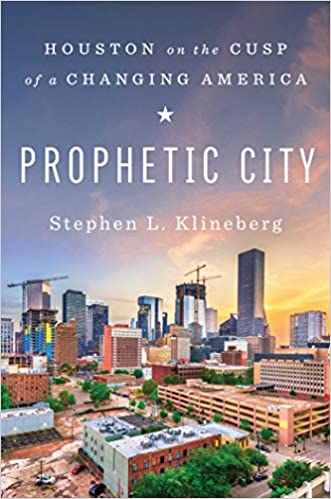You have /5 articles left.
Sign up for a free account or log in.
 Prophetic City: Houston on the Cusp of a Changing America by Stephen L. Klineberg
Prophetic City: Houston on the Cusp of a Changing America by Stephen L. Klineberg
Published in June 2020
By 2045, the U.S. is projected to be a majority-minority society. Houston is already there.
To get a sense of Houston's current racial/ethnic demographics (our nation's fourth-largest city with a population of roughly 2.3 million), I created the following table*:
| Houston 2019 | U.S. 2019 | U.S. 2045 | |
| Hispanic or Latino | 44.8% | 18.3% | 24.6% |
| Non-Hispanic White (Anglo) | 24.6% | 60.4% | 49.7% |
| Black or African American | 22.5% | 13.4% | 13.1% |
| Asian | 6.5% | 5.9% | 7.9% |
| Multiracial | 2.1% | 2.7% | 3.8% |
A book on Houston seems particularly well timed to our current moment. If we want to understand where the U.S. is heading, and where we in the higher education industry are going, there may be no better place to look than at Houston.
Let's stay with demographics for a moment before we talk about this excellent new book on Houston, Prophetic City. A quick look at the racial-ethnic profile of the future cohorts of traditional-age college students (age 18 and below) demonstrates how rapidly our higher education student body will change.
Today, just over half (50.4 percent) of the under-age-18 population is white, and 25.3 percent are Hispanic, 13.8 percent are black and 5.1 percent are Asian. By 2060, just over a third (36.5 percent) are projected to be white, where 32 percent will be Latinx, and almost 8 percent will be Asian. (With multiracial people undercounted in these percentages, and growing very quickly.) Does the current mix of faculty and staff look anything like these numbers? Do we have a pipeline in place so that those who work in higher education will resemble tomorrow's students?
Prophetic City combines two of my favorite nonfiction genres: city biographies and sociological studies.
Houston is a city that I've never visited. After reading Prophetic City, I want to go.
What I did know about Houston, before reading Prophetic City, mostly centered around Rice University. Anyone who works in higher education is highly aware of Rice's quality; the school is ranked in the top 20 national universities and the top 10 for best undergraduate teaching.
What I learned from reading Prophetic City is that Houston is that the city is not only home to one of the world's finest universities. It is also one of the nation's fastest-growing and most dynamic cities. Named by GQ magazine as the "New Capital of Southern Cool," Houston seems like the place to go for restaurants and other cultural amenities.
Did you know that Houston has the most total park acreage of any large U.S. city? I didn't. While I did know about Houston's rapid population growth, I hadn't quite realized how relatively affordable the city's housing market is. And while I knew about Harvey and Enron, I did not know about all the biking paths, museums and farmers markets that Houston had to offer.
What is laudable about Prophetic City is that this is not a book of Houston boosterism. Klineberg is a sociology professor, and Prophetic City is a sociological look at a complex and challenging large urban area. The book does not shy away from cataloging Houston's problems. These include growing levels of inequality, inadequately funded public schools and underdeveloped zoning and land-use regulations.
What Klineberg does beautifully in this book is to show that the challenges that Houston is grappling with today will be the challenges that the rest of us will be facing tomorrow. Houston provides a demographic, and perhaps an economic window, on what the U.S. will look like in a fully globalized and multiracial/multiethnic future.
The social and economic realities of Houston seem to be dramatically out of step with the political rhetoric and policies pursued by both Texas's statewide politicians and what is coming out of Washington.
Klineberg is hopeful that Houston will follow a more progressive path in the future, with more significant public investment in infrastructure and services. He argues that Houston will need to invest in its people, particularly as economic activity related to extractive energy industries inevitably gives way to renewables. I'm not quite as optimistic as Klineberg, as an alternative future where Houston doubles down on a low-tax, low-regulation and low-public-investment way of living can easily be envisioned.
What Prophetic City did make me want to do is visit Houston, a city that does not get nearly enough visitors. If Rice holds a conference on learning innovation (assuming that in-person meetings are not a thing of the past), I'd like to attend.
What can you tell us about Houston?
What biographies of cities would you recommend?
What are you reading?
_____________
*sources and notes:
- https://www.census.gov/quickfacts/houstoncitytexas
- https://www.census.gov/quickfacts/fact/table/US/PST045219
- https://www.brookings.edu/blog/the-avenue/2018/03/14/the-us-will-become-minority-white-in-2045-census-projects/
Columns don't add up to 100 percent, as I've collapsed some categories. The multiracial category dramatically undercounts the percentage of people from multiracial backgrounds, as race is a social category, and percentages rely on self-reporting. Pew estimates that around 7 percent of Americans are multiracial.




